
Subscribe to continue reading
Subscribe to get access to the rest of this post and other subscriber-only content.


Subscribe to get access to the rest of this post and other subscriber-only content.

Subscribe to get access to the rest of this post and other subscriber-only content.
Still lifes are not particularly exciting for me to paint – though I paint them. Painting still lifes is good practice, however, because of the varying shapes, textures and colors involved, along with the challenge of complex composition. Painting still lifes actually helps in painting portraits. In fact, painting in any style assist with painting any other style. You can look at this painting and see all the separate elements I had to paint. There were decisions and layers of brush strokes involved with each item.
I’m working up to the 10,000 paintings said to be necessary before one can expect to claim “mastery” in oil painting. I’m still under 1000 paintings, so I have a ways to go. It’s time for another portrait. Have a wonderful weekend. Winifred
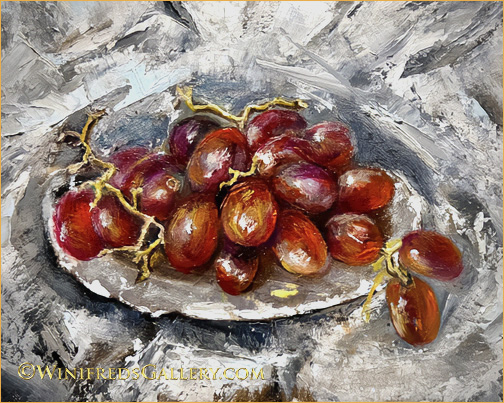
What a journey this painting has had. It was intended as a little practice exercise – to paint something I would not particularly care about. To allow that the painting would not be “precious” as they say, allows one to be more comfortable experimenting – such that what or how one paints just doesn’t matter. So that was my mindset which carried throughout the painting process – as you will see. Below is the reference image – a little yellow plate with grapes on a brown surface.
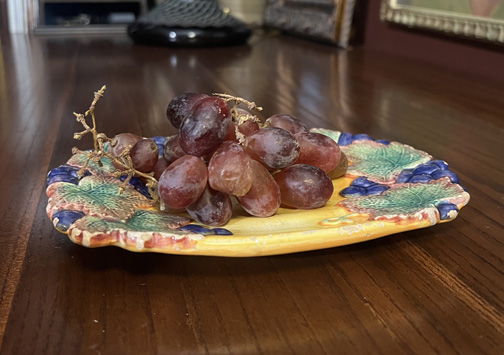
Below is a crop from my initial painting of the plate and grapes.
When I stood back to look, it was apparent I was doing my same old realism and I didn’t want to do that. So, I scraped the paint off the plate. I think it’s rather pretty but I wanted something different from just pretty. It’s getting less hard for me to to paint something relatively well (the plate) and then decide – NO – scrape it off and try again. I maintained the grapes throughout. Below was the next attempt.
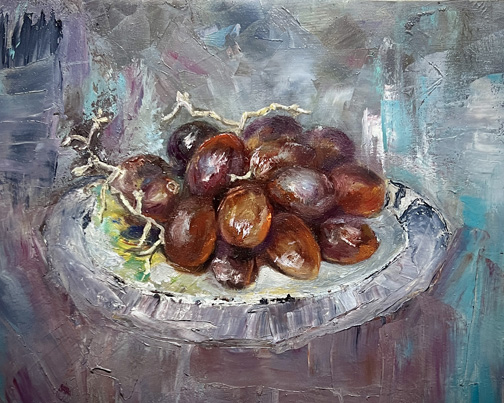
Above, I painted over plate and the background and started adding random colors. Again, I decided NO and scraped off the paint. Then I decided I would approach it differently. I would find my little yellow plate and set up what would be a background and table covering and work from this structure. Below is that photo of what would be my background reference image:
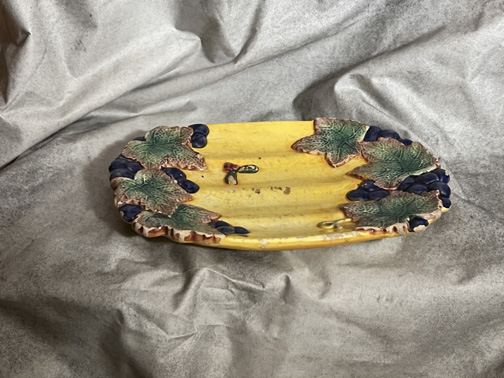
Above: I thought that having this reference would assist me with what I wanted to accomplish. I found a piece of stiff cloth I like to use because it will hold stiff folds. It’s actually a piece of house painters floor protective covering which has vinyl on one side. I set the little yellow plate on it – no grapes – and I photographed the plate against the cloth which gave me a reference background and table covering. Below was my first attempt using the reference to form my background.
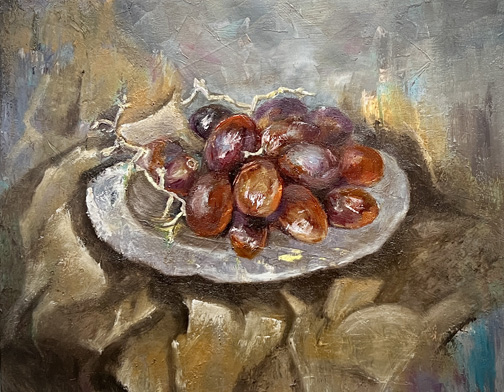
Above: Rather interesting colors and shapes but not what I wanted. Here again, the plate shape is painted with a sense of realism reflecting of the original shape than I wanted, if not the color. Thus, I’m heading down the wrong path again. I struggle with this. Below, I try again.
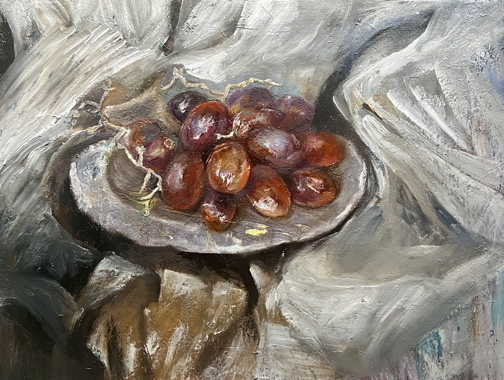
Above: Not so bad except that the color turned to mud because I hadn’t sufficiently dried nor scraped off the tan/gold paint you see before it. This time I would allow it to dry over night and reapply cooler paint colors during my next paint session. Below- the final PERHAPS.

In actuality, the light colors in this painting are very neutral – not so warm hued as they appear in this photo of the painting. (It could just be my screen.) I intensified the grape color, added deeper reds to the grapes and added a couple additional grapes as I always enjoy doing. I admit I never took the grape stems too seriously. I succeeded in a looser background with lots of texture, random abstract strokes and lots of energy. The background is not necessarily pretty but it’s not BORING. That’s important to me. To have energy and not to be boring was my only objective for this little exercise – which turned out NOT to be such a “little” exercise. In keeping with the intention to not make this painting “precious”, I’m going to sand down the background as soon as this painting dries more. I have found that the result of sanding a painting during the painting process or after, most often enhances the painting. It allows some of the underlying colors to come through and it affects the edges in some way. I expect it to become more interesting. I’m not sure what will happen. If the results are particularly interesting I will show you. If you actually made it this far – thank you for sharing this journey with me. Winifred
This past week, rather than creating a completely new painting, I decided to experiment on an existing painting. Painting backgrounds is an ongoing challenge for many painters. This is certainly the case for me. A background should be an integral part of the painting, created within the context the development of the painting, not as an after thought or a final thought. I was not happy with my original background of this painting, even though it resembled the original reference photo, I thought it could be more interesting. I’ve been practicing swerving lines and small floral and foliage elements during the past year. As someone explained on YouTube, painting is a physical exercise, and it requires effort and practice to teach the hand how to make different brush strokes. Think of the gymnast who has practiced and can perform a certain technique very well – but has no facility in another technique and must work hard to get her body to perform it. So it is with brushstrokes. It is few painters who can paint any subject matter very well. You should see how awkwardly my hand moves when painting the petals of roses or a cluster of petals in a lilac or hydrangea. Portraits over all are hardest to paint, (the nose. eyes, lips) but floral elements, require the most complex brushstrokes. For me, painting fruit is easiest. For a while now, I’ve wanted to add decorative floral elements to the backgrounds of my paintings. Last week I added some floral decorative elements to the portrait I painted. It was subtle but it was there. This week, I added floral elements more substantially to this still life painting above. I made quite a few other changes as well. The original painting is below. You may well think the simpler version is preferable. Important to me was giving my hand practice adding graceful swerves and floral elements which you see in the painting above – and there will be more because I am still practicing.
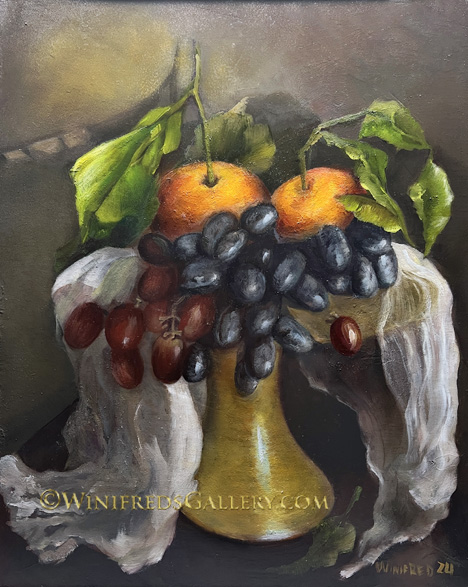
I think of the destruction and terror which must have been experienced by the hurricane victims – now trying to rebuild their lives. I also think of the terror of the Haitians who’ve been placed in harm, accused repeatedly of eating their neighbors cats and dogs. All very sad. Have a good weekend. Winifred
I’m going to explain what I’ve been doing. It’s been fun. I can’t use solvents in my studio and the use of solvent in oil painting is part of the traditional painting process. It’s used for brush cleaning, to create a thin wash to work out the values of the painting or to paint the first layer with a thin wash of color and to thin oil paint throughout to one’s desired consistency. Mixed with oil paint, the paint dries faster. Sometimes a solid layer of the mid color of the painting is applied overall to the surface and shapes are wiped out to create initial shapes in the painting.
for these reasons, I feel a little handicapped in not being able to use solvent. Many people can’t use it. There can be an allergic reaction which causes head aches, nausea or whatever. The adverse reaction can develop over time. Some of these products are odorless – which I think is a terrible thing. You can’t even tell if solvent is building up in the studio. Without going too far into this. I heard someone mention an alternative. The suggestion came from a very experienced oil painter who post lots of technical info on YouTube. He said †hat for quite a while now, he has used a watercolor wash as a background or first painting layer. Originally he used Acrylic. It “dries” quickly, but the fact is it should cure for 1 to 2 days before painting on it in oil, so he changed to watercolor. So, I decided to try watercolor A normal person would likely have tested this process using watercolor from a set they may have at home, or might purchase inexpensively on Amazon. Not being a normal person, I decided I would make a set of watercolor colors – specific to what I might use for subdued background colors. I probably looked at 30 YouTube videos to learn how to make a watercolor binder. The process is more complicated and requires more ingredients than in making oil paint which I’ve made for years. The other thing is that after grinding the watercolor it has to dry which can take 2 to 3 days curing before using the product. I guess you don’t have. to let it dry but its harder to control the amount on the brush if it’s wet. I initially thought I would make 3 colors. however, I made 12. I couldn’t help it. I had the pigments already and in fact, I had all the ingredients I needed – gum Arabic, glycerin, honey, and clove oil. There are many recipes which can affect the functionality and artistry of watercolor. It’s been fun to learn about which is why I couldn’t get a painting done last week. I spent days studying, and days making the watercolor. I could have gone a much simpler route but I really enjoy making stuff. For my purpose they’re fine. Whether or not they’re really any good – I have no ideabut they will work for me.
Then I selected a painting to test my new watercolor as a background and an initial wash.The painting was interesting to copy. It’s not really a copy but I certainly copied many of the elements from the painters work. I like the fact that I used bristle brushes only. I don’t think I’ve ever done that before. In addition to creating texture which I love, it keeps all the edges soft. I’ll have to try that with a portrait. Actually, I did use a small sable for those delicate little champagne grapes. I then added a border and allowed a couple pieces of fruit to roll out the frame – something I like to do – most often with grapes.
Professional WC is most often in very small containers. My watercolors are large allowing me to insert a large brush into the containers for large strokes rather than small sable brushes most often used in WC painting. Notice my name is not on the painting. I don’t think the artist would like his name on it either. Well, that’s my story. Have a great weekend. Winifred
This is the second time I’ve painted a group of “three tomatoes. I waited until I was finished with the painting above before I looked back on the painting (below) created 5 years ago or so in order that it not influence me. I remembered my first tomato painting, below, was very blended and pretty realistic. I worked hard to make sure this latest painting (above) was more textured and loose. It was taken outdoors with a blue sky shining on them giving the cool highlights and creating significant contrast. Evergreens, form the background.
Neither painting was easy. I remember how difficult it was to blend the slight shifts in gradients in the first painting, below. This latest painting, the one above, should have been easier and it probably would have been had I not worked so hard to be true to the many shapes, ridges and color variations of the heirloom tomatoes. It has much deeper in color, more burgundy with green variations.
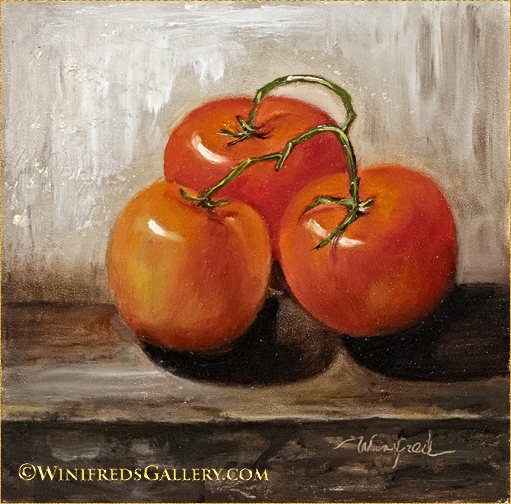
I like both paintings for different reasons. I definitely like the background and tabletop of the painting above. Choosing a favorite is always complicated. Have a great week. Winifred
I created this painting throughout the days of the Democratic National Convention. On each of those days, I went to my studio well before the convention started and ended my painting day well after the convention ended each day. I painted a fifth day as well. I like Kamala Harris. I think shell provide honest, legal and compassionate governance and I will certainly vote for her. This painting, as with all others, have many hours involved in the creation. I’m not a fast painter and for me each and every element requires consideration . If I were to do it again – which I won’t, I would do some things differently. I had gotten pretty far with the painting – nearly finished actually, when I stepped back and saw a big compositional error. The issue was too big to ignore, too big “not to see”. When that happens it’s a big job to make the correction, but I did so. I enjoy these shapes and colors. I always enjoy painting grapes. I used real fruit when photographing this still life set up. I couldn’t get the digital image to look like the painting today and I tried for way too long. The grapes in particular are problematic because of all the choppy little colors on the black grapes in particular. On the painting they are smoother, lower contrast and it looks nice. I tried many things to remedy and eventually gave up. I’m sure there’s a way but I’m tired.
It’s cool and rainy today and the same is predicted for the coming week. To reminisces: August, is a time in the Western part of Washington state, when there are many weddings scheduled – or at least that use to be the case – you could count on August to be sunny, warm and rain-less. It was September or October before the rain might come – but the weather has changed so much. Many weddings use to take place in my gardens – gardens which I created. Before painting with oil, I painted with flowers, shrubs and trees. I’m glad I don’t have to be concerned about that anymore. I was always the self selected photographer for weddings in my gardens as well. After 2 years of my wedding venue and wedding photography activities, I quit the entire operation. The gardens and my photography remained in demand but can you imagine all of this activity at your home each weekend of the summer? But, it’s pretty fun to look back on the photos. The great thing about hosting this activity is some of the long time friends which remain. I sold this property in 2010.
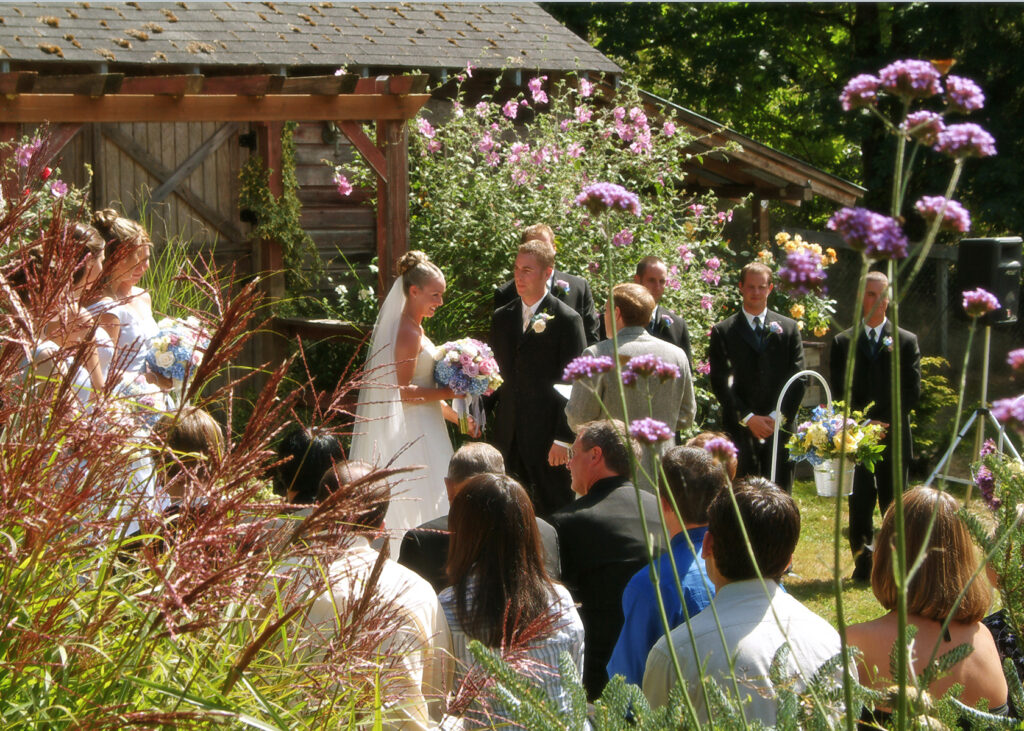
Above photos, are three of the many places a bride could choose as her background.
Well, that’s it for my trip down memory lane which started with me thinking about cool weather and rain in August. Have a great weekend. GO KAMALA!! Winifred
Unlike with most flowers, I’ve always enjoyed the many phases of life of the sunflower and I have paintings which reflect this. However, I didn’t have a painting quite like this. While going through my files this past week, I came upon this reference photo – I knew instantly I had to paint it. I’m not sure you can tell exactly what it is. It’s actually two large overlapping sunflower heads. All the petals have fallen off and it’s large sunflower seeds have begun to dry. I love the “curls” and the way the light is hitting the dramatic shapes. At 16 x12 , this painting is relatively large and has tremendous visual impact and presence.
I hope you enjoy it. Have a wonderful weekend. Winifred
I keep a folder on my computer titled “still lifes to paint”. This image has been in that folder since 2018. I set ip the still life and photographed it. I really like the image. I love the rough looking vase ( I guess it’s a vase) against the multi colored silk scarf over the shinny gold cloth. In no way did I feel I could paint it however. Besides, I found the digital file so pretty, I thought there was nothing I could bring to it anyway. And so, for all these years it sat. Every time I’ve come across it, however, I react to it in an admiring fashion. This week I decided I would try it. Afterall, I’ve been practicing for 7 years now. Unlike with painting roses, I actually enjoyed the process – I wasn’t miserable the whole time. Do you wonder what those orange objects are? I’m really not sure. I tried to make them resemble fruit or vegetables moreso than they did when I took them out of the bag of plastic objects I acquired from Goodwill long ago. Some objects in that bag actually looked like apples or oranges, others were not identifiable. They were shapes, with color and that’s all I really cared about.
You won’t believe what I’ve chosen to paint the coming week. I ‘m going back to misery painting roses. I keep thinking it’s got to get easier at some point. I took photos today and I’ve made my selection, guaranteeing you’ll see another “rose painting” in a week or two. The photo is pretty cute. Bye for now. Thank you for looking. Winifred